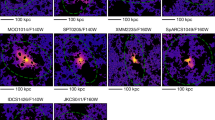Abstract
THERE are two opposing interpretations of the small dispersion σ1∼0.35 mag in the absolute magnitudes M1 of the brightest members of rich clusters of galaxies measured by Sandage1. In one view, advanced, among others, by Peebles2,3, it is assumed that there is a universal cluster luminosity function, and that the value of σ1 and of the variation of M1 with cluster richness can be explained as the statistical result of drawing the brightest member from a set of clusters obeying this function. There is therefore nothing physically remarkable about the brightest member, and its luminosity is determined by the same mechanism as that which determines the luminosity of the fainter members. The opposing view, which has been advanced by Peach4, Sandage1, and Tremaine and Richstone5, claims that the small dispersion is due to special conditions governing the formation or evolution of the brightest member, and is therefore entirely or in part independent of the luminosity function of the other cluster members. On this view one evokes either special conditions at the epoch of galaxy formation1, or a mechanism, such as galactic accretion6, which governs the size and luminosity of the most massive galaxy in such a way as to give a small dispersion in the metric magnitude. The weakness of the statistical model, according to its opponents, is its inability to account for σ1 without postulating a luminosity function steeper than those directly observed. The opposing view is open to the criticism that it is either ad hoc or that the mechanisms of galaxy evolution are too uncertain to lead to reliable conclusions. Here, we discuss the two interpretations in the light of new results and suggest that the case against the statistical model may not be as strong as sometimes suggested.
This is a preview of subscription content, access via your institution
Access options
Subscribe to this journal
Receive 51 print issues and online access
$199.00 per year
only $3.90 per issue
Buy this article
- Purchase on Springer Link
- Instant access to full article PDF
Prices may be subject to local taxes which are calculated during checkout
Similar content being viewed by others
References
Sandage, A. R. Astrophys. J. 205, 6 (1976).
Peebles, P. J. E. Astrophys. J. 153, 13 (1968).
Geller, M. J. & Peebles, P. J. E. Astrophys. J. 206, 939 (1976).
Peach, J. V. Nature 223, 1140 (1969).
Tremaine, S. D. & Richstone, D. O. Astrophys. J. 212, 311 (1977).
Hausman, M. A. & Ostriker, J. P. Astrophys. J. 224, 320 (1978).
Austin, T. B. & Peach, J. V. Mon. Not. R. astr. Soc. 168, 591 (1974).
Austin, T. B., Godwin, J. G. & Peach, J. V. Mon. Not. R. astr. Soc. 171, 135 (1975).
Godwin, J. G. & Peach, J. V. Mon. Not. R. astr. Soc. 181, 323 (1977).
Sandage, A. R. Astrophys. J. 173, 485 (1972).
Sandage, A. R. & Hardy, E. Astrophys. J. 183, 743 (1973).
Oemler, A. Astrophys. J. 209, 693 (1976).
Author information
Authors and Affiliations
Rights and permissions
About this article
Cite this article
GODWIN, J., PEACH, J. Brightest members of clusters of galaxies. Nature 277, 364–366 (1979). https://doi.org/10.1038/277364a0
Received:
Accepted:
Issue Date:
DOI: https://doi.org/10.1038/277364a0
Comments
By submitting a comment you agree to abide by our Terms and Community Guidelines. If you find something abusive or that does not comply with our terms or guidelines please flag it as inappropriate.



